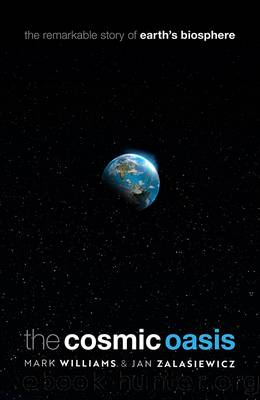The Cosmic Oasis by Mark Williams

Author:Mark Williams [Mark Williams && Jan Zalasiewicz]
Language: eng
Format: epub
ISBN: 9780192584748
Publisher: OUP Oxford
Published: 2022-05-04T02:11:10+00:00
The Green Revolution
By the 1940s, and despite the impact of a global war, the human population continued to grow and at the end of that decade exceeded 2.5 billion people. It was during this decade that high-producing forms of maize and wheat began to be developed as a means to enhance food security, and together with new varieties of rice, these would help to avert starvation, and feed a growing human population. Initially, this work began with the idea of countering the impacts of parasitic fungi such as ârustâ, which attack wheat and many other plants, and which had plagued crops since prehistory. The Romans felt the effects of these fungal infestations and celebrated the festival of Robigalia towards the end of April each year, invoking the god Robigus to intervene and preserve the crops.
Mexico had suffered two severe blights from a form of rust in 1939 and 1941 which threatened its production of wheat. Out of this was born the international maize and wheat improvement centre of Mexico, and here began a Green Revolution that would spread throughout the world.13 One of the scientists of this Mexican institute was the American Norman Borlaug. He led the development of new strains of wheat that were resistant to rust and were also high-yielding, and these would eventually be grown in many other parts of the world. He developed dwarf varieties with shorter stems, that were particularly suitable to poor soils where artificial fertilizers were used (non-dwarf varieties would grow so rapidly that they would topple over under the weight of their own grain). There were other centres of the Green Revolution too, and during the 1960s the Philippines became a focal point for improved varieties of rice that were adopted throughout South East and South Asia.
The Green Revolutionâs combination of new crop strains, fertilizer, mechanization, pesticides, and irrigation had a dramatic impact on what farmers could grow. In 1961 about 1.87 tonnes of rice could be produced per hectare of land, but by 1980 this had risen to about 2.75 tonnes and is now approaching 5 tonnes. There have been similar increases in the yields of maize and wheat, and in virtually every staple crop that is used by humans, with potatoes and bananas giving the highest yield with over 20 tonnes per hectare. This impressive feat of technology has fed many people, and it also means that compared to the 1960s only 30 per cent of the same area of arable land is now needed to generate the same produce.14 But since 1960 the human population has more than doubled, and much of the cereal crop is used to feed the animals that we eat, especially cattle, or is manufactured into biofuels. So overall, the amount of land used for crops has risen.
Borlaugâs work and those of his colleagues are credited with keeping alive about one billion of the Earthâs human population, and in 1970 he received a Nobel prize for his work. He knew then that the crop technologies
Download
This site does not store any files on its server. We only index and link to content provided by other sites. Please contact the content providers to delete copyright contents if any and email us, we'll remove relevant links or contents immediately.
Seven Skeletons by Lydia Pyne(1048)
The Ultimate Weight Loss Bible: Lose Weight and Burn Fat - Explanations and Recipes suited to you incl. Low Carb, Keto Diet, 5:2 Diet, Mediterranean diet, Dash Diet, Paleo Diet & More by Roberts Jessica Sarah(498)
Dinosaurs of Darkness by Thomas H. Rich;Patricia Vickers-Rich;(487)
Assembling the Dinosaur by Lukas Rieppel(448)
Fantastic Fossils by Donald R. Prothero(422)
Tracking the Golden Isles by Anthony J. Martin(368)
Dinosaurs—The Grand Tour, Second Edition: Everything Worth Knowing About Dinosaurs from Aardonyx to Zuniceratops by Pim Keiron(345)
Fossil Forensics: Separating Fact from Fantasy in Paleontology by Bergman Jerry & Snow Philip & Sherwin Frank & Johnson Fred & Stuart MaryAnn(336)
The Teachers by Alexandra Robbins(285)
An Alfred Russel Wallace Companion by Charles H. Smith (editor); James T. Costa (editor); David A. Collard (editor)(156)
Explaining Life Through Evolution by Prosanta Chakrabarty(154)
Fauna by Christiane Vadnais(135)
Lifeâs Grandeur: The Spread of Excellence From Plato to Darwin by Stephen Jay Gould(119)
Awakening: A Novel of Aliens and Consciousness by Stephan A. Schwartz(107)
Unfit for Purpose: When Human Evolution Collides With the Modern World by Adam Hart(106)
The Zombic Hunch: Extinction of an Intuition? by Daniel Dennett(102)
The Expanding Circle: Ethics, Evolution, and Moral Progress by Singer Peter(97)
Leonardo's Mountain of Clams and the Diet of Worms by Stephen Jay Gould(96)
The Future of Humanity (Second Edition) by Zhouying Jin; & Lane Jennings & Ying BAI(93)
